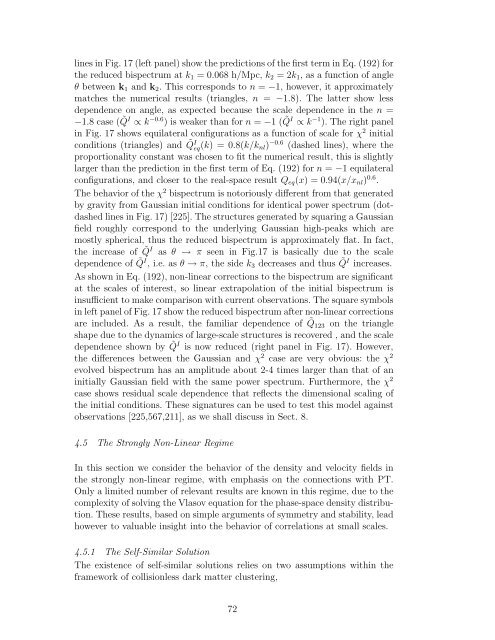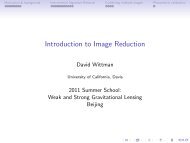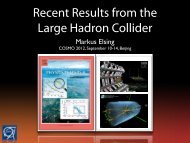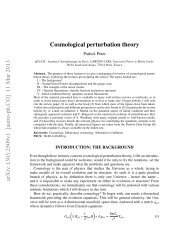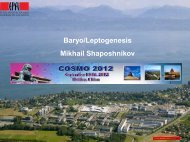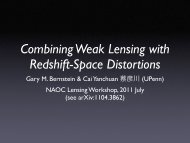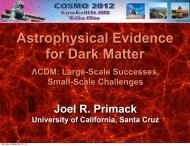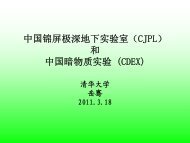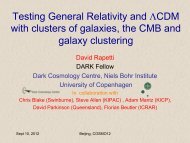Large-Scale Structure of the Universe and Cosmological ...
Large-Scale Structure of the Universe and Cosmological ...
Large-Scale Structure of the Universe and Cosmological ...
Create successful ePaper yourself
Turn your PDF publications into a flip-book with our unique Google optimized e-Paper software.
lines in Fig. 17 (left panel) show <strong>the</strong> predictions <strong>of</strong> <strong>the</strong> first term in Eq. (192) for<br />
<strong>the</strong> reduced bispectrum at k1 = 0.068 h/Mpc, k2 = 2k1, as a function <strong>of</strong> angle<br />
θ between k1 <strong>and</strong> k2. This corresponds to n = −1, however, it approximately<br />
matches <strong>the</strong> numerical results (triangles, n = −1.8). The latter show less<br />
dependence on angle, as expected because <strong>the</strong> scale dependence in <strong>the</strong> n =<br />
−1.8 case ( ˜ Q I ∝ k −0.6 ) is weaker than for n = −1 ( ˜ Q I ∝ k −1 ). The right panel<br />
in Fig. 17 shows equilateral configurations as a function <strong>of</strong> scale for χ 2 initial<br />
conditions (triangles) <strong>and</strong> ˜ Q I eq(k) = 0.8(k/knl) −0.6 (dashed lines), where <strong>the</strong><br />
proportionality constant was chosen to fit <strong>the</strong> numerical result, this is slightly<br />
larger than <strong>the</strong> prediction in <strong>the</strong> first term <strong>of</strong> Eq. (192) for n = −1 equilateral<br />
configurations, <strong>and</strong> closer to <strong>the</strong> real-space result Qeq(x) = 0.94(x/xnl) 0.6 .<br />
The behavior <strong>of</strong> <strong>the</strong> χ 2 bispectrum is notoriously different from that generated<br />
by gravity from Gaussian initial conditions for identical power spectrum (dotdashed<br />
lines in Fig. 17) [225]. The structures generated by squaring a Gaussian<br />
field roughly correspond to <strong>the</strong> underlying Gaussian high-peaks which are<br />
mostly spherical, thus <strong>the</strong> reduced bispectrum is approximately flat. In fact,<br />
<strong>the</strong> increase <strong>of</strong> ˜ Q I as θ → π seen in Fig.17 is basically due to <strong>the</strong> scale<br />
dependence <strong>of</strong> ˜ Q I , i.e. as θ → π, <strong>the</strong> side k3 decreases <strong>and</strong> thus ˜ Q I increases.<br />
As shown in Eq. (192), non-linear corrections to <strong>the</strong> bispectrum are significant<br />
at <strong>the</strong> scales <strong>of</strong> interest, so linear extrapolation <strong>of</strong> <strong>the</strong> initial bispectrum is<br />
insufficient to make comparison with current observations. The square symbols<br />
in left panel <strong>of</strong> Fig. 17 show <strong>the</strong> reduced bispectrum after non-linear corrections<br />
are included. As a result, <strong>the</strong> familiar dependence <strong>of</strong> ˜ Q123 on <strong>the</strong> triangle<br />
shape due to <strong>the</strong> dynamics <strong>of</strong> large-scale structures is recovered , <strong>and</strong> <strong>the</strong> scale<br />
dependence shown by ˜ Q I is now reduced (right panel in Fig. 17). However,<br />
<strong>the</strong> differences between <strong>the</strong> Gaussian <strong>and</strong> χ 2 case are very obvious: <strong>the</strong> χ 2<br />
evolved bispectrum has an amplitude about 2-4 times larger than that <strong>of</strong> an<br />
initially Gaussian field with <strong>the</strong> same power spectrum. Fur<strong>the</strong>rmore, <strong>the</strong> χ 2<br />
case shows residual scale dependence that reflects <strong>the</strong> dimensional scaling <strong>of</strong><br />
<strong>the</strong> initial conditions. These signatures can be used to test this model against<br />
observations [225,567,211], as we shall discuss in Sect. 8.<br />
4.5 The Strongly Non-Linear Regime<br />
In this section we consider <strong>the</strong> behavior <strong>of</strong> <strong>the</strong> density <strong>and</strong> velocity fields in<br />
<strong>the</strong> strongly non-linear regime, with emphasis on <strong>the</strong> connections with PT.<br />
Only a limited number <strong>of</strong> relevant results are known in this regime, due to <strong>the</strong><br />
complexity <strong>of</strong> solving <strong>the</strong> Vlasov equation for <strong>the</strong> phase-space density distribution.<br />
These results, based on simple arguments <strong>of</strong> symmetry <strong>and</strong> stability, lead<br />
however to valuable insight into <strong>the</strong> behavior <strong>of</strong> correlations at small scales.<br />
4.5.1 The Self-Similar Solution<br />
The existence <strong>of</strong> self-similar solutions relies on two assumptions within <strong>the</strong><br />
framework <strong>of</strong> collisionless dark matter clustering,<br />
72


